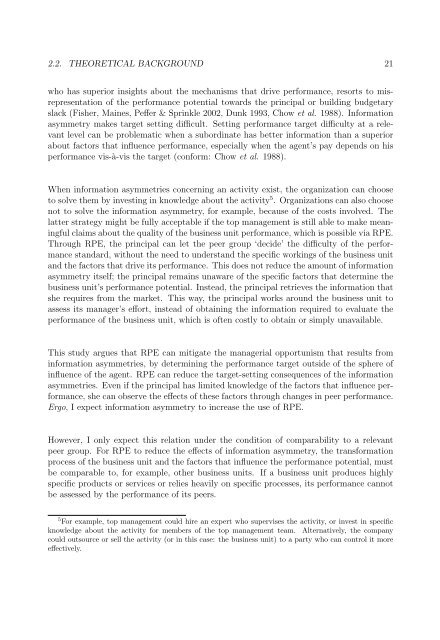pdf - Nyenrode Business Universiteit
pdf - Nyenrode Business Universiteit
pdf - Nyenrode Business Universiteit
You also want an ePaper? Increase the reach of your titles
YUMPU automatically turns print PDFs into web optimized ePapers that Google loves.
2.2. THEORETICAL BACKGROUND 21<br />
who has superior insights about the mechanisms that drive performance, resorts to misrepresentation<br />
of the performance potential towards the principal or building budgetary<br />
slack (Fisher, Maines, Peffer & Sprinkle 2002, Dunk 1993, Chow et al. 1988). Information<br />
asymmetry makes target setting difficult. Setting performance target difficulty at a relevant<br />
level can be problematic when a subordinate has better information than a superior<br />
about factors that influence performance, especially when the agent’s pay depends on his<br />
performance vis-à-vis the target (conform: Chow et al. 1988).<br />
When information asymmetries concerning an activity exist, the organization can choose<br />
to solve them by investing in knowledge about the activity 5 . Organizations can also choose<br />
not to solve the information asymmetry, for example, because of the costs involved. The<br />
latter strategy might be fully acceptable if the top management is still able to make meaningful<br />
claims about the quality of the business unit performance, which is possible via RPE.<br />
Through RPE, the principal can let the peer group ‘decide’ the difficulty of the performance<br />
standard, without the need to understand the specific workings of the business unit<br />
and the factors that drive its performance. This does not reduce the amount of information<br />
asymmetry itself; the principal remains unaware of the specific factors that determine the<br />
business unit’s performance potential. Instead, the principal retrieves the information that<br />
she requires from the market. This way, the principal works around the business unit to<br />
assess its manager’s effort, instead of obtaining the information required to evaluate the<br />
performance of the business unit, which is often costly to obtain or simply unavailable.<br />
This study argues that RPE can mitigate the managerial opportunism that results from<br />
information asymmetries, by determining the performance target outside of the sphere of<br />
influence of the agent. RPE can reduce the target-setting consequences of the information<br />
asymmetries. Even if the principal has limited knowledge of the factors that influence performance,<br />
she can observe the effects of these factors through changes in peer performance.<br />
Ergo, I expect information asymmetry to increase the use of RPE.<br />
However, I only expect this relation under the condition of comparability to a relevant<br />
peer group. For RPE to reduce the effects of information asymmetry, the transformation<br />
process of the business unit and the factors that influence the performance potential, must<br />
be comparable to, for example, other business units. If a business unit produces highly<br />
specific products or services or relies heavily on specific processes, its performance cannot<br />
be assessed by the performance of its peers.<br />
5 For example, top management could hire an expert who supervises the activity, or invest in specific<br />
knowledge about the activity for members of the top management team. Alternatively, the company<br />
could outsource or sell the activity (or in this case: the business unit) to a party who can control it more<br />
effectively.
















